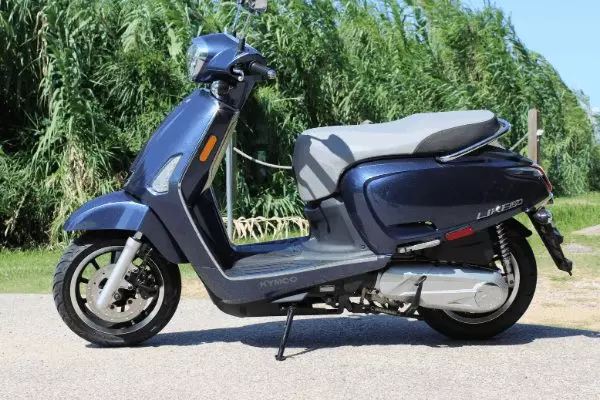Thinking about riding a scooter? Are they easy to ride? Are they hard to ride? Is it hard to balance? So many questions! Don’t be intimidated!
Riding a scooter is an attainable skill made easier if you have experience driving a car and riding a bike. Both give you experience interacting with drivers on the road with biking adding in more experience driving defensively on 2 wheels. Take a step by step approach to make scooting a more pleasant experience.
With driving and bike riding experience, you are well on your way to scooting success, but you can start where you are with some exposure and practice even without the biking or significant. I had zero experience with riding anything on two wheels beyond my road bike when I first looked into buying a scooter. Below are the steps I took to get up to speed (pun intended).
- Sign up for a motorcycle (scooter) safety course
- Wear your safety gear
- Choose a scooter that is comfortable to you
- Choose the right size engine size for your needs
- Find a low-to-no traffic spot to get comfortable
- Practice. Practice. Practice.
1. Sign up for a motorcycle (scooter) safety course
All states require an endorsement added to your standard drivers license to operate a scooter. There are different rules in this space, but many require a class. Even if your state does not require the course, it is highly recommended to find one. The skills to ride a motorcycle were not intuitive to me.
I’m in Texas, and the endorsement and therefore, the class, is required for scooters with an engine size over 50cc. I had never ridden a scooter when I decided I might want to ride one, so I searched for a class that offered scooters instead of just motorcycles. I had to drive over an hour each day of the class, but it was worth it to me to get comfortable with an actual scooter.
There was an online component I had to complete before I went to class, and then we had some classroom time before we even touched a scooter. Once they were assigned, they really did start you at the basics with how to start them, and then you’d turn it on and off repeatedly. Then you would essentially glide with them off. It was a steady progression, but by the end of if you are taking tight turns, stopping quickly, and you actually have to traverse a 2 by 4. I was a nervous nelly, but by the end of it, I was much more confident and prepared for driving on two wheels.
2. Wear Your Safety Gear
There is something to be said about the safety net you get automatically by just wearing the gear that will help protect you in case of an accident. We actually had a rider in my safety course that was an experienced scooter rider already that took a turn too fast and had an accident in the parking lot. She was skinned up and very thankful for the full-face helmet she was wearing. That was just in the speed she could reach in a parking lot!
Helmet, motorcycle rated pants, gloves and jacket along with footwear that covers your ankle are recommended. For the class, they had helmets we could borrow, but you had to wear pants, long sleeves, footwear that covered your ankle and some type of gloves. For the class, they did not have to be motorcycle rated.
3. Choose a Scooter Comfortable to You
I sat on quite a few scooters before I bought the one I did. The larger ones just felt more difficult for me to control when riding or at a stop, so there is some value in making sure you feel like you can reach everything you need to reach in order to be safe. My heart almost broke when I couldn’t ride home the prettiest scooter I had ever seen. It was just too tall for my frame. Both feet need to be planted comfortably to keep you stable to start and stop rolling safely.
Also, consider if you’ll be doing any long rides. There are touring models, bigger tires, more upright and conversely more bent over positions. All of this matters for comfort and enjoyment.
4. Choose the Right Size Engine for Your Needs
This could be a whole post on its own, but you don’t need the biggest motor they offer if you will be coasting 30 mph on your college campus for your rides. That said, if you desire to hop on a freeway, you will not want to hop on one that is a 150cc. Yes, they can get up to 60, but they are not designed to go 60 mph and beyond for extended periods. Do your homework in this space, but find a balance to avoid having a scooter too powerful or too wimpy for how you plan to do ride.
5. Find a low-to-no traffic spot to get comfortable
Whether you have taken a class or not when you decide to start riding, you’ll want to find a good spot to learn how the scooter operates. The best place to become proficient with this is where you will have few other cars. Quiet, low traffic neighborhoods or parking lots will be very helpful. Keep an eye out for spots like this, and know that weekend mornings can also work in your favor with even lower traffic. Having a safe spot to get acquainted with your scooter will help you get your skills up to speed with limited pressure. Ultimately, this will increase your confidence to help you tackle the open road safely and securely.
6. Practice. Practice. Practice.
Yes, this is very closely related to step 5, but I can’t stress how important it is to practice to boost your confidence for your safety, as well as, those around you! At a minimum, you’ll want to make sure you’re good at the following:
- Turning your scooter on and off
- Easing forward and how much, how quickly to turn the handle to go
- Stopping. Get used to how much brake to apply at different intervals.
- Turning. It isn’t so much turning as leaning, right?
- U-Turns. Look with your eyes where you want your tires to be.
- Parking. Unexpected fun when you can’t remember the rules, using your center stand or where to store your helmet.
- Backing up.
Get comfortable doing all of these things before you hit the road, but also remember to practice these skills regularly. It isn’t often that I have to make a u-turn or a sudden braking movement, so practicing these skills keeps them fresh for those rare times I need to pull them out to keep myself from an accident with the pressure of cars around you.
Wrap It Up
Scooters are fun to ride, but it can be intimidating if you haven’t ridden one before. Do some research and take some incremental steps to expose you to scooters, and you’ll find the joy in scooting around pretty quickly!





